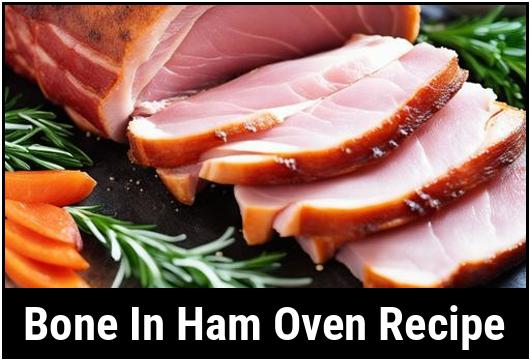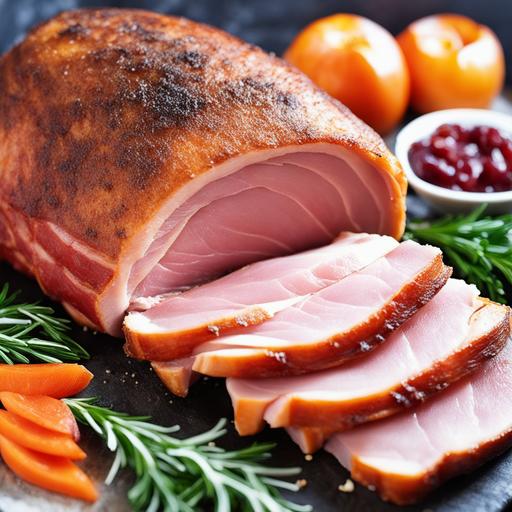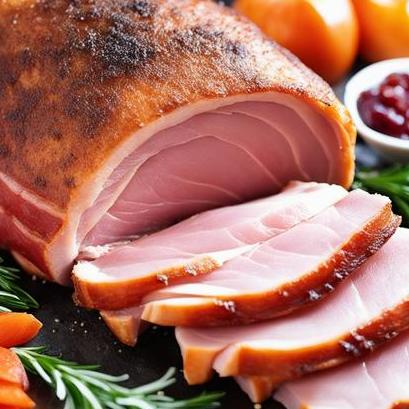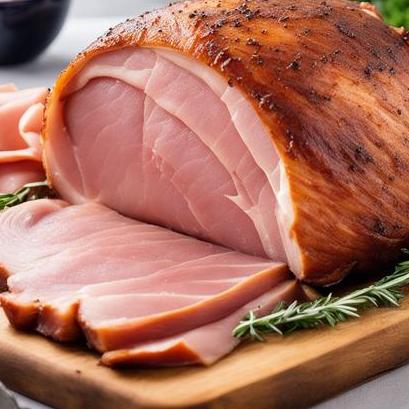
The Perfect Bone-In Ham Oven Recipe: An Exquisite Culinary Delight
Welcome to the world of tantalizing flavors and succulent aromas! If you’re craving a mouthwatering dish that will take center stage at your dinner table, then look no further than the delightful bone-in ham. This comprehensive guide will take you on a gastronomic journey, combining food science, culinary techniques, and handy tips to ensure your bone-in ham is a culinary masterpiece. So, let’s dive into the art of preparing and cooking a bone-in ham.
I. Understanding the Food Science Behind Bone-In Ham
Bone-in ham is a magnificent cut of pork that is prepared by curing or smoking a pig’s hind leg. This process gives it a distinct flavor, texture, and delightful pink hue that sets it apart from other cuts. The bone-in feature not only enhances the presentation but also adds complexity to the flavors. Understanding the food science behind this culinary delight will help you appreciate the intricate techniques involved in creating the perfect bone-in ham.
During the curing process, the ham is generally soaked in a brine solution, commonly containing sugar, salt, and various spices. This brining step not only imparts flavors but also helps retain moisture, ensuring a juicy and tender final product. Consequently, the flavors penetrate the meat, enhancing its taste and creating a harmonious blend of sweetness and savory notes.
II. Selecting and Cleaning the Ideal Bone-In Ham
When venturing into the world of bone-in ham, selecting the best piece will make a significant impact on the final dish. Here are a few tips to assist you in choosing the perfect ham:
-
Look for a high-quality ham with even marbling throughout the meat, as this ensures exquisite tenderness and flavor.
-
Opt for a bone-in ham that is well-trimmed, ensuring minimal fat around the edges. This not only facilitates even cooking but also prevents excessive greasiness.
-
Verify that the packaging date is recent to ensure optimal freshness.
Once you’ve acquired the finest bone-in ham, it’s crucial to dedicate attention to cleaning. Rinse the ham thoroughly under cold running water to eliminate any potential debris. This step ensures that the flavor profile and overall appearance remain pristine, setting the stage for a truly remarkable culinary experience.
III. Preparing the Bone-In Ham to Perfection

Proper preparation is key to amplifying the flavors and textures of your bone-in ham. Here’s a step-by-step guide to help you expertly prepare this culinary masterpiece:
-
Thawing: If your ham is frozen, it’s crucial to thaw it completely before cooking. This can be achieved by refrigerating the ham for approximately 24 hours per 5 pounds. Alternatively, you may opt for the cold water method, replacing the water every 30 minutes.
-
Preheating: Preheat your oven to 325°F (163°C). This temperature maintains a gentle heat, enabling the ham to cook evenly while preserving its succulence.
-
Scoring and Glazing: With a sharp knife, gently score the surface of the ham in a crisscross pattern, creating diamond-shaped incisions. This scoring allows the glaze to penetrate and infuse the ham with delightful flavors.
For the glaze, combine brown sugar, honey, Dijon mustard, cloves, and a splash of apple cider vinegar. Mix until the ingredients meld together into a luscious, sticky consistency. Generously brush the ham with the glaze, ensuring it clings to each crevice for maximum flavor.
-
Baking: Place the prepared ham, cut side down, on a baking rack inside a roasting pan. This allows the heat to circulate evenly, resulting in uniform cooking. Tent the ham loosely with aluminum foil to retain moisture during the initial stages of baking.
-
Cooking Time: The cooking time varies based on the size and weight of your bone-in ham. As a general guideline, allow approximately 15 minutes of cooking time per pound. However, it is imperative to use a meat thermometer to ensure optimal doneness.
IV. Tips, Variations, and Doneness Checks for the Perfect Bone-In Ham

-
Basting: Throughout the cooking process, regularly baste the ham with the glaze to maintain a delightful caramelized exterior, while keeping the meat moist and tender.
-
Flavor Variations: Experiment with different glazes to customize your bone-in ham. Consider incorporating ingredients such as maple syrup, pineapple juice, orange zest, or even a touch of cayenne pepper for a touch of heat.
-
Doneness Checks: To guarantee your bone-in ham is cooked to perfection, insert a meat thermometer into the thickest part of the meat, avoiding contact with the bone. The internal temperature should read 145°F (63°C) for optimal safety and taste.
-
Resting Period: Once your bone-in ham reaches the desired temperature, remove it from the oven and tent it with foil. Allow it to rest for approximately 15-20 minutes before slicing. This period allows the juices to redistribute, ensuring enhanced tenderness and juiciness.
V. Recipe for a Heavenly Bone-In Ham

Now that you’ve mastered the art of preparing and cooking a bone-in ham let’s revel in the pleasure of an exquisite recipe:
Ingredients:
-
7-8 lb bone-in ham
-
1 cup brown sugar
-
1/4 cup honey
-
2 tablespoons Dijon mustard
-
1 teaspoon ground cloves
-
2 tablespoons apple cider vinegar
Instructions:
-
Follow the cleaning and preparation steps mentioned earlier to ensure your bone-in ham is ready for the mouthwatering glaze.
-
Preheat your oven to 325°F (163°C).
-
Score the ham’s surface in a crisscross pattern, creating diamond-shaped incisions.
-
In a bowl, combine the brown sugar, honey, Dijon mustard, cloves, and apple cider vinegar to create the glaze.
-
Generously brush the ham with the glaze, ensuring it seeps into the scores.
-
Place the ham, cut side down, on a baking rack inside a roasting pan and tent loosely with foil.
-
Bake the ham for the recommended cooking time, approximately 15 minutes per pound.
-
Throughout the cooking process, baste the ham with the glaze every 30 minutes.
-
Use a meat thermometer to check for doneness, ensuring an internal temperature of 145°F (63°C).
-
Once cooked to perfection, remove the ham from the oven and tent with foil for a resting period of 15-20 minutes.
-
Carve the ham and serve slices alongside your favorite accompaniments for a truly spectacular feast.
VI. Beware of Overcooking or Undercooking

As with any culinary adventure, there is always a fine line between undercooking and overcooking the bone-in ham. Overcooking can result in a dry and tough texture, while undercooking poses the risk of consuming undercooked pork. Therefore, it is essential to closely monitor the cooking time and internal temperature using a reliable meat thermometer. Thoroughly following the suggested cooking guidelines will ensure your bone-in ham emerges as a delectable centerpiece.
VII. In Summary
Congratulations! You’ve embarked on a journey that combines culinary finesse, food science, and a passion for flavor. By understanding the food science behind bone-in ham, selecting the finest piece, mastering the cleaning and preparation process, experimenting with variations, and capturing that ideal doneness, you are now equipped to create an extraordinary culinary experience. So, gather your ingredients, don your apron, and prepare for the accolades that await as you unveil your very own masterpiece – the divine bone-in ham. Enjoy!
FAQS On Bone In Ham Oven Recipe
What Type Of Ham Should I Use For This Oven Recipe?
It is recommended to use a bone-in ham for the best flavor and texture. This can be a spiral-cut or whole ham.
Do I Need To Preheat The Oven Before Cooking The Ham?
Yes, it is important to preheat the oven to ensure even cooking and prevent the ham from drying out.
How Long Should I Cook The Ham In The Oven?
The cooking time will depend on the weight of the ham. As a general rule, cook the ham for 15-20 minutes per pound at 325°F. Use a meat thermometer to ensure an internal temperature of 145°F.
Should I Cover The Ham While It Is Cooking In The Oven?
Yes, it is recommended to cover the ham with foil or lid to prevent it from drying out. You can uncover the ham during the last 20-30 minutes of cooking for a glazed or crispy exterior.
How Do I Know When The Ham Is Fully Cooked?
Use a meat thermometer to check the internal temperature of the ham. It should read 145°F. You can also check for doneness by piercing the thickest part of the ham with a fork. The juices should run clear and the meat should be tender.



